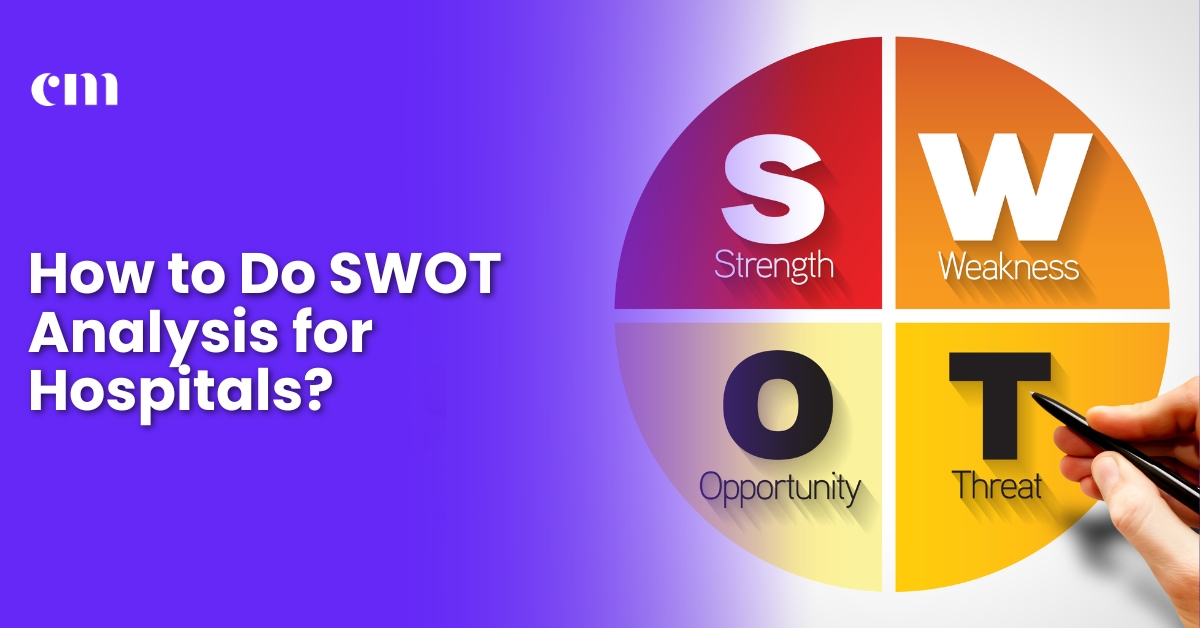In the competitive healthcare industry, hospitals must continuously adapt to changes in technology, patient needs, and regulatory requirements.
Contents
ToggleConducting a SWOT analysis for hospitals is an essential strategic tool that helps identify strengths, weaknesses, opportunities, and threats.
This comprehensive guide will provide step-by-step instructions on how to perform a detailed SWOT analysis tailored specifically for hospitals.
What is a SWOT Analysis?
A SWOT analysis is a strategic planning method used to evaluate the internal and external factors that influence an organization’s performance.
For hospitals, this involves a thorough examination of operational efficiencies, quality of patient care, market positioning, and compliance with healthcare regulations.
By understanding these factors, hospitals can develop strategies to improve services, increase patient satisfaction, and maintain financial stability.
Components of SWOT Analysis
- Strengths: Internal attributes that give the hospital a competitive edge.
- Weaknesses: Internal challenges that hinder the hospital’s performance.
- Opportunities: External conditions that the hospital can exploit for its advantage.
- Threats: External factors that could jeopardize the hospital’s success.
Importance of SWOT Analysis for Hospitals
Performing a SWOT analysis for hospitals is crucial for several reasons:
- Strategic Planning: Helps in setting realistic goals and formulating effective strategies.
- Resource Optimization: Assists in allocating resources efficiently to areas that need them most.
- Risk Mitigation: Identifies potential threats, allowing the hospital to develop contingency plans.
- Enhancing Competitiveness: Recognizes unique strengths to leverage in the market.
According to a survey by the American Hospital Association, hospitals that regularly conduct SWOT analyses are 30% more likely to experience growth in patient satisfaction and operational efficiency.
9 Easy Steps to Conduct a SWOT Analysis for Hospitals
1. Assemble a Multidisciplinary Team
Gather a team that represents various departments within the hospital:
- Clinical Staff: Doctors, nurses, and technicians.
- Administrative Personnel: Management, HR, and finance.
- Support Services: IT, maintenance, and housekeeping.
- Patient Representatives: Feedback from patients can provide valuable insights.
Having a diverse team ensures that all aspects of the hospital’s operations are considered.
For example, in a case study published in the Journal of Healthcare Management in 2021, a hospital improved its emergency department efficiency by 25% after including nurses and administrative staff in their SWOT analysis team.
2. Identify Strengths
List internal factors that give the hospital an advantage over competitors. These could include:
- Highly Qualified Staff: Board-certified specialists and experienced nurses.
- Advanced Medical Technology: Cutting-edge equipment like MRI machines and robotic surgical systems.
- Accreditations and Awards: Recognitions such as Joint Commission accreditation or Magnet status for nursing excellence.
- Strong Community Relationships: Partnerships with local organizations and charities.
Example Table: Hospital Strengths
| Strength | Description |
|---|---|
| Advanced ICU Facilities | Equipped with the latest life-support technology. |
| Patient Satisfaction | 90% positive feedback in annual surveys. |
| Research Programs | Active clinical trials in oncology and cardiology. |
3. Recognize Weaknesses
Identify internal areas that need improvement. Common weaknesses might be:
- Outdated Infrastructure: Facilities that require renovation or modernization.
- Staff Shortages: High turnover rates or unfilled positions.
- Limited Services: Absence of specialized departments like neurology or pediatrics.
- Inefficient Processes: Long patient wait times or bureaucratic hurdles.
For instance, a hospital might find that its patient admission process is causing delays.
By identifying this as a weakness, the hospital can implement electronic health records to streamline admissions.
4. Explore Opportunities
Look for external factors that the hospital can leverage. These might include:
- Growing Population: An increasing local population could lead to higher demand for healthcare services.
- Technological Advances: Telemedicine and remote monitoring technologies.
- Policy Changes: Government grants for hospitals adopting green initiatives.
- Community Needs: Rising cases of chronic diseases that require specialized care.
According to the Centers for Disease Control and Prevention, telehealth visits increased by 154% in March 2020 compared to the same period in 2019. Hospitals can seize this opportunity to expand their telemedicine services.
You can also read:
- 10 Ways to Develop a Patient-Centric Marketing Campaign
- Healthcare Branding in 2024: The Complete Guide
5. Assess Threats
Identify external factors that could negatively impact the hospital’s operations. Common threats include:
- Increased Competition: New hospitals or clinics opening in the area.
- Regulatory Changes: New healthcare laws that could increase operational costs.
- Economic Downturns: Reduced patient spending on elective procedures.
- Pandemics: Outbreaks that strain resources and affect staff availability.
For example, during the COVID-19 pandemic, many hospitals faced shortages of personal protective equipment (PPE), leading to increased operational challenges.
According to the World Health Organization, global demand for PPE was 100 times higher than normal in 2020.
Example Table: Hospital Threats
| Threat | Description |
|---|---|
| Regulatory Changes | New staffing ratio laws increasing labor costs. |
| Technological Disruption | Competitors offering advanced telehealth services. |
| Insurance Constraints | Lower reimbursements from insurance companies. |
6. Create a SWOT Matrix
Organize the identified factors into a SWOT matrix to visualize the hospital’s strategic position.
SWOT Matrix for XYZ Hospital
| Positive | Negative | |
|---|---|---|
| Internal Factors | Strengths – Experienced staff – Advanced technology |
Weaknesses – Outdated facilities – Limited services |
| External Factors | Opportunities – Community partnerships – Telemedicine growth |
Threats – Increased competition – Regulatory changes |
7. Develop Strategic Actions
Use the SWOT analysis to formulate actionable strategies.
- Strengths and Opportunities (SO Strategies): Leverage strengths to capitalize on opportunities.
- Action: Use experienced staff to expand telemedicine services.
- Weaknesses and Opportunities (WO Strategies): Address weaknesses to take advantage of opportunities.
- Action: Upgrade facilities to attract community partnerships.
- Strengths and Threats (ST Strategies): Use strengths to mitigate threats.
- Action: Utilize strong reputation to counter increased competition.
- Weaknesses and Threats (WT Strategies): Minimize weaknesses to avoid threats.
- Action: Improve financial management to prepare for regulatory changes.
8. Implement and Monitor Strategies
Develop a detailed action plan with timelines and responsible parties.
- Set SMART Goals: Specific, Measurable, Achievable, Relevant, Time-bound.
- Example: Increase telemedicine consultations by 20% within the next six months.
- Allocate Resources: Assign budgets and personnel to each strategic action.
- Monitor Progress: Use Key Performance Indicators (KPIs) to track success.
- Example KPIs: Patient satisfaction scores, wait times, revenue growth.
9. Review and Update the SWOT Analysis
A SWOT analysis is not a one-time activity. Regularly review and update it to reflect changes in the internal and external environment.
- Quarterly Reviews: Schedule regular meetings to assess progress.
- Feedback Mechanisms: Implement surveys and suggestion boxes for staff and patients.
- Adjust Strategies: Be prepared to pivot strategies based on new information.
Conclusion
Conducting a thorough SWOT analysis for hospitals is essential for strategic planning and maintaining a competitive edge.
By identifying strengths, weaknesses, opportunities, and threats, hospitals can develop effective strategies to improve patient care, optimize operations, and achieve long-term success.
Moreover, regular updates and involving a multidisciplinary team ensure that the SWOT analysis remains relevant and actionable.
If you need a professional hospital marketing agency that can help you with SWOT analysis, you can contact Crawl Math.


